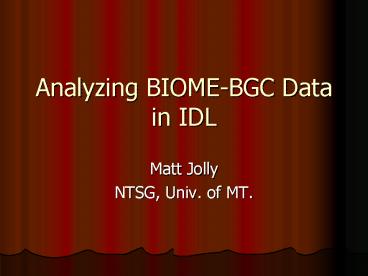Analyzing BIOMEBGC Data in IDL - PowerPoint PPT Presentation
1 / 14
Title:
Analyzing BIOMEBGC Data in IDL
Description:
Analyzing BIOME-BGC Data in IDL. Matt Jolly. NTSG, Univ. of MT. ... 44 6 wf.soilw_outflow. 70 7 cs.cwdc. 509 8 epv.proj_lai. Hierarchical Data Organization ... – PowerPoint PPT presentation
Number of Views:131
Avg rating:3.0/5.0
Title: Analyzing BIOMEBGC Data in IDL
1
Analyzing BIOME-BGC Data in IDL
- Matt Jolly
- NTSG, Univ. of MT.
2
Introduction
- Discuss the format of common BIOME-BGC outputs
- Determine the best way to read outputs into IDL
variables - Apply data processing function to analyze data
3
BIOME-BGC Outputs
- Three principle output types from BGC
- Daily
- Monthly
- Annual
- Monthly and Annual outputs are the average of the
daily values - The outputs are defined in the Biome-BGC ini file
4
Data Format
- Data are always organized sequentially
- I.E. a series of bytes that are read in by the
program - BGC writes out data for each time step iteration,
so the files are ordered as follows - If there were two variables and two sim days
- (Var1,Day1)(Var2,Day1)(Var1,Day2)(Var2,Day2)
- If BGC writes data out as single precision
floating point values, how many bytes should the
above file be?
5
Reading BGC data in IDL
- The hardest part is dimensioning the array
correctly. The rest we have done before. - Dimension the input variable as follows
- Number of variables
- Number of intervals in a year
- 365 for daily, 12 for monthly, can be omitted for
annual - Number of years
6
The IDL Variable
- Lets say we are reading in daily data and in the
INI file we gave it 23 variables to write out and
told the model to run for 44 years. - Dimension the IDL variable as follows
- Bgcdata fltarr(23,365,44)
- Better than bgcdata ftlarr(369380L)
- Note organization into logical groups
(days,years) is done by IDL
7
- DAILY_OUTPUT (keyword)
- 23 (int) number of daily variables to output
- 20 0 ws.soilw
- 21 1 ws.snoww
- 38 2 wf.canopyw_evap
- 40 3 wf.snoww_subl
- 42 4 wf.soilw_evap
- 43 5 wf.soilw_trans
- 44 6 wf.soilw_outflow
- 70 7 cs.cwdc
- 509 8 epv.proj_lai
8
Hierarchical Data Organization
Year1
Year2
Day1
Day2
Day365
Day1
Day365
Vars1 - 10
Vars1 - 10
Vars1 - 10
Vars1 - 10
Vars1 - 10
Only this level is actually stored, the other
levels are just for organization
9
Recommendations
- Subset the data
- Trans data5,,
- Define variables to index the array
- Trans 5
- Plot,datatrans,,
10
Summarizing data
- The TOTAL function sums an array based on an
index - Syntax
- Result total(array, arraydim)
- Array is the array to sum and arrayindex is the
dimension to sum by - For example
- Trans data5,,
- Help, trans -gt fltarr(365,44)
- Transtot total(trans,1)
- This sums the trans for each year
11
Total used to get the mean
- Simply divide the result by the original size of
the dimension - Mean total(trans,1) / 365
12
Regressions
- IDL is a powerful statistical package, especially
once you have read the data into local variables - A common task is to determine whether or not
there is a linear relationshiop between variables - We can do this with regressions
13
REGRESS
- Ordinary least squares regression
- Result REGRESS( X, Y,, CONSTvariable
, CORRELATIONvariable , FTESTvariable) - T REGRESS(LAIMAX,TRANSTOT,CORRELATION CORR)
14
Exercise
- Read a BIOME-BGC .dayout file into IDL
- Subset transpiration and NPP
- Sum both variables
- Plot Transpiration as a function of NPP































